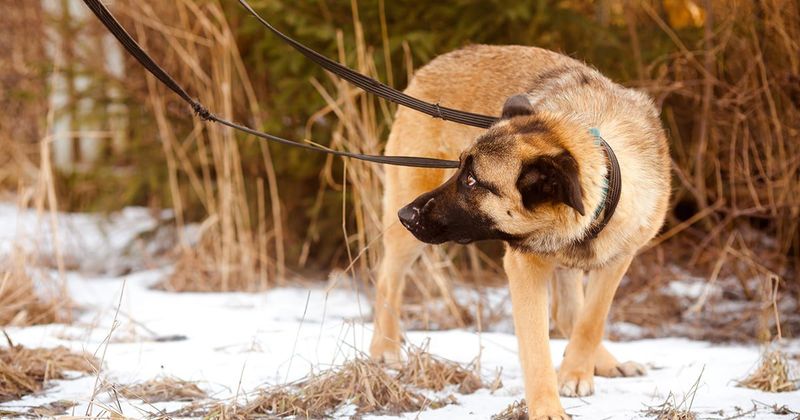Dogs are empathetic creatures, often mirroring their owner’s emotions. Understanding the signs that your dog might be absorbing your stress can help you take steps to alleviate it. Here are ten clear indicators that your dog feels your stress too.
Change in Sleep Patterns
Ever notice your dog sleeping more or less than usual? Changes in sleep patterns can be a sign they’re sensing your stress. For instance, your dog may become restless at night, pacing or frequently changing positions. Their usual afternoon nap might be interrupted by anxious energy, mirroring your own unease.
Dogs are intuitive creatures, picking up on cues like body language and tone of voice. When you’re stressed, they may feel the need to stay alert. This constant vigilance can lead to disrupted sleep cycles, similar to how we might toss and turn during stressful times.
Appetite Fluctuations
Has your pup suddenly become a picky eater, or, conversely, more ravenous? Appetite fluctuations are a common sign of stress in dogs. Just like humans, dogs can lose their appetite or comfort eat when feeling anxious. You might find them sniffing their food and walking away or, surprisingly, devouring their meal in record time.
Stress-related appetite changes can stem from the emotional connection they share with you. Observing these eating habits can give insights into their emotional state, reflecting your own stress levels. Keep an eye on their eating patterns to identify any trends.
Increased Barking or Whining
Increased vocalizations such as barking or whining can be a sign of stress. Dogs may resort to barking at seemingly nothing, or whining more than usual as a way to communicate their emotional turmoil. It’s as if they’re saying, “I sense something’s off.”
Pay attention to the timing and frequency of these vocalizations. They might correlate with particularly stressful moments, such as after a tense phone call or a difficult day at work. Understanding these vocal patterns can help in managing your dog’s stress-related behaviors.
Destructive Behavior
Noticed your favorite shoes chewed up unexpectedly? Destructive behavior in dogs is often linked to stress. This behavior might manifest as chewing, digging, or even tearing up furniture. For many dogs, these destructive actions are a way to deal with the stress they’re sensing from their owners.
This coping mechanism is not unlike human stress habits, such as nail-biting. If these behaviors become frequent, it might be time to evaluate your own stress levels and see how they might be affecting your furry friend.
Clingy or Withdrawn Behavior
Your dog following you around the house more than usual? Alternatively, they might hide away in a quiet corner. Such clingy or withdrawn behavior can indicate stress. Dogs might become overly attached, shadowing your every move, or they might seek solitude, avoiding interaction.
This behavior reflects their emotional mirroring of your stress. Clinginess may be their way of providing comfort or seeking reassurance. Conversely, withdrawal may suggest they’re overwhelmed by the stress in the environment. Observe these behaviors to gauge their emotional state.
Excessive Licking or Grooming
Excessive licking or grooming in dogs can be a telltale sign of stress. You might notice your dog licking their paws or grooming themselves incessantly. This compulsive behavior can be compared to how humans might fidget or bite their nails under stress.
The repetitive nature of licking can be soothing for dogs, providing a form of self-comfort. If this behavior persists, it could be a reflection of ongoing stress, likely mirroring your own emotional state. Monitoring this behavior is key to understanding your dog’s stress levels.
Loss of Interest in Play
Has your playful pup lost interest in their favorite toys? A loss of interest in play is a common sign of stress in dogs. If your dog ignores their beloved ball or frisbee, it might indicate they’re feeling your stress.
Play is essential for a dog’s mental and physical well-being. When they lose interest, it’s often a sign they’re emotionally affected. This withdrawal from play can mirror your own feelings of stress or fatigue. Encouraging playtime is vital to counteract this emotional withdrawal.
Panting or Pacing
Notice your dog panting or pacing more than usual? These behaviors can be stress indicators. Panting might occur even when your dog hasn’t been active, and pacing can seem aimless but is often a response to underlying stress.
Dogs may exhibit these signs when they pick up on your stress cues. It’s their way of coping with the tension in their environment. If these behaviors become routine, consider evaluating the stressors in both your lives. Helping your dog manage their stress is crucial to their overall health.
Trembling or Shaking
Trembling or shaking in dogs can be a subtle yet significant sign of stress. Your dog might shake as if they’re cold, even in warm conditions. This physical response can be likened to how humans might shiver when anxious or stressed.
Such signs should not be ignored, as they often indicate an emotional upheaval. Identifying the root cause of their stress can help alleviate their discomfort. Observing these signs early can prevent further stress-related health issues, ensuring your dog’s well-being.
Changes in Body Language
Dogs communicate a lot through body language. Have you noticed your dog with its tail tucked or ears back more often? These changes can indicate stress. A lowered head, avoiding eye contact, or a stiff posture can speak volumes about their emotional state.
Understanding these subtle cues is key to recognizing stress in your dog. Just like humans, dogs express emotions through non-verbal signals, and changes in their usual body language can reflect stress. Observing these signs can enhance the emotional bond you share.










